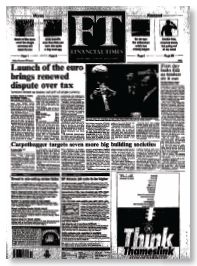Financial history provides modern insight
Gale, part of Cengage Learning, has launched a digital archive of the Financial Times newspaper. Siân Harris found out what newspaper archives offer to researchers

Economies around the world have been going through testing times and the effects on house prices, banking deals and corporate finances are being seen everywhere. But this is not a new phenomenon. The past century or so has seen plenty of high and low points in the financial markets. Studying what happened in the past is a valuable tool for politicians, researchers and people throughout finance and business as they try to make sense of what is happening and plan for future recovery.
‘Economic history has until recently been ignored by students but now there is a huge upturn in interest,’ observed Seth Cayley, publisher for media history at Cengage.
This is where newspapers like the Financial Times can help. It has charted finance and business news around the world since its launch in 1888. Being a daily newspaper, it also provides context, such as who were the prime ministers and presidents at the time, as well as any conflicts, business scandals and political uncertainties.
Like most large newspapers, the Financial Times has had an online presence for several years. However, newspaper websites are not primarily intended as research tools. They only cover recent years and the information is not tagged and organised for systematic searching. They are also presented as a series of HTML pages so do not provide the context of the original newspapers.
The launch of Cengage’s new Financial Times archive goes back to the newspaper’s birth and contains almost 800,000 fully-searchable pages. This includes every article, advertisement and market listing, in the context of the full page and issue on the day they were published. Each item has been categorised by subject or topic and the resource also includes commissioned essays by historians. At the moment the archive goes up to 2006 but each year another year will be added to the archive.
‘This is a superb time to launch an archive that supports finance and business research,’ commented Cayley, ‘and the technology is finally good enough that we can actually do the Financial Times justice.’
Cengage has been putting back issues of the Financial Times onto microfilm for about 20 years. This meant that all the digitisation could be carried out from microfilms.
Cengage carries out the digitisation in its UK offices but optical character recognition and other processing is done by HTC Global Services, Cengage’s partner in India.
Cengage already offers digital archives of The Times and the weekly magazine The Economist, as well as various projects with the British Library and its State Papers Online programme. The plan – hopefully over the next year - is to put all its newspaper archives onto the same platform (The Times and The Economist are currently on a legacy platform). This will pave the way for tools that link the products together, enabling cross-searching by subject or event, for example.

The world’s first illustrated weekly newspaper The Illustrated London News (ILN) will also join this platform as the next newspaper archive to be launched. Digitisation of this was carried out at the same time as that of the Financial Times but the challenges were different. There are no microfilms of the ILN so digitisation is being done from the original print copies. One of the biggest challenges with this was tracking down complete issues. ILN included several supplements, which were often missing. Most of the back issues are from the Mary Evans Picture Library, South London with gaps filled from the collections of the National Library of Scotland.
The valuable nature of the originals raised another digitisation challenge. Unmarked vans delivered them in small batches to Cengage’s UK offices. Cengage has assembled cameras from the Swedish firm Hasselblad and can capture up to 1,500 digital images per day. Acquiring good scans from print newspapers does not only require expensive equipment. According to Cayley, a flat page is important for obtaining a good scan – and he says that they haven’t found any tool better for this than a household iron.
ILN will not be the last such project. ‘There is an insatiable appetite for newspaper archives. They are a fantastic resource for both teaching and research,’ Cayley said.






